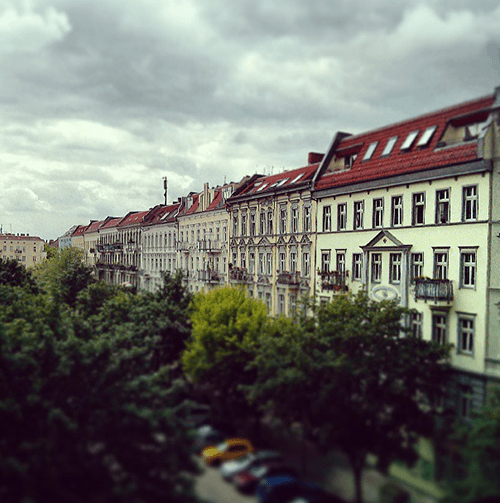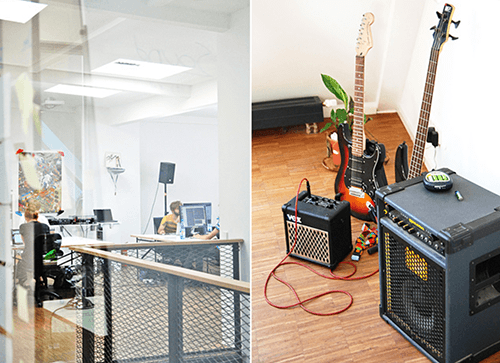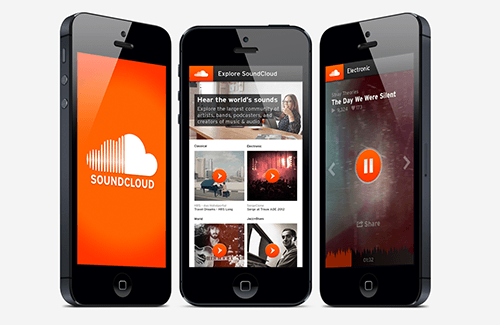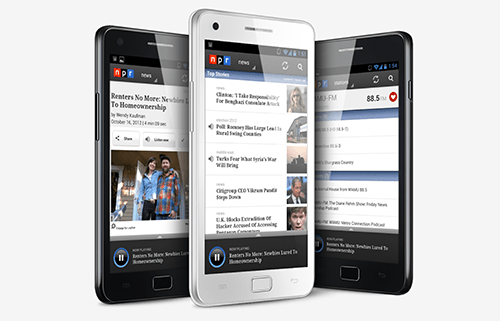Interview With Benjamin Dauer From Soundcloud
Influenced by his father, an architect, Benjamin Dauer had an early fascination with design, which came first from watching his father draw by hand and then connecting these drawings to physical space. When his father began using digital programs like AutoCAD, Benjamin became equally inspired, seeing it as a way for static design to achieve dimension.
Unlike many designers, Benjamin never formally trained at a design school. Instead, he learned his skills through observation, self-directed study and work experience. He currently is senior product designer at National Public Radio (NPR). Prior to that, he was lead product designer at SoundCloud, a position that took him and his wife to Berlin, where he helped to shape the audio service across multiple platforms. Away from his desk, he is an experimental musician and composer.
I met Benjamin in a Berlin bookstore and cafe called Shakespeare & Sons, during his transition from SoundCloud to NPR. He used to come here often to read, drink coffee and eat fresh bagels. Shakespeare & Sons is located in Prenzlauer Berg near Helmholtzplatz Park. The area is known for its young families.
During our conversation, we paused many times for the adorable toddlers passing by. Benjamin spoke about his passion for music and how he enjoyed being involved in the design and music communities, sharing his creative skills for good causes. He was named a “SoundCloud Hero” for raising awareness of white nose syndrome and colony collapse disorder, two diseases that affect bat and bee populations in the US.

Benjamin’s neighborhood, Prenzlauer Berg. (Image source: Benjamin Dauer)
Q: What had made you decide to move to Berlin and join SoundCloud?

When I discovered SoundCloud nearly six years ago, it became the perfect platform to share my music with many communities. Over time, I became actively involved in projects such as the Disquiet Junto. After a while, and after being named a SoundCloud Hero, I was approached by them about a design role here in Berlin. I decided that working at SoundCloud would be the perfect marriage of design and music, and it involved living abroad, so I took the job.
And, of course, Berlin is such an exciting, youthful city. Moving here with my wife has definitely been a new adventure for us. Who knows what the future will bring. But for now, Berlin is our home. It was not easy for us to settle for the first few months. For instance, Germany has a very complicated rental process. But overall, we are having a great time here.
Q: How do the design teams work at SoundCloud and NPR?
The team at SoundCloud is a fairly small design team, but it is continually expanding. At the moment, about eight people are on the design team working here at the Berlin headquarters. The team consists of Web and mobile designers, prototypers, and researchers. We also closely collaborate with project managers, as well as with the engineering, insights, search, and brand communications teams.

SoundCloud’s current office. (Image: Wechsellook)
I think that a design team should be compact and focused on specific projects and goals. Bigger teams can inhibit quick decision-making. I promote the agile methodology in my design process. We have daily stand-up meetings for better communication between colleagues. This transparency is also key to working collaboratively across teams. Every small change we make will impact tens of millions of users.
The team at NPR is very clear about its priorities. Its focus is on usability more than anything else. This philosophy also applies to the team here at SoundCloud. Going from a non-profit organization to a truly international startup was quite an insane transition for me. People working here stay highly engaged, and we all have crazy enthusiasm about our product.

Benjamin Dauer’s design of the NPR Music app won the Communication Arts’ Interactive Competition award.
Designers are experience creators, and being a good listener is very important. As designers, we solve problems with our creative thinking. By asking the right qs, we can quickly address problems. We need to have specific reasons for every step moving forward — for example, why the drop shadow is necessary in a certain case, or why we use a particular color or typeface or interaction or animation. Many companies use data analysis to define design, to determine what the users want. I think designers should be willing to take risks and trust their intuitions.
Q: What is your reaction to the current trend of flat design?
The trends of visual design in the tech industry change rapidly. From skeuomorphic to flat design, what really matters is contextually applying the right design. Ultimately, these styles are just tools to enhance the user’s experience. Usability of the app should be the focus.
Q: Where do you seek inspiration?
I am inspired by many things. This comes from my everyday observation of architecture, objects, street scenes and even small details like the shadows of the city. I also like to read. I encourage designers to read not only design-related books, magazine and articles, but also books from other genres. For example, I am very interested in philosophy. It is a great way to improve critical- and conceptual-thinking skills. Reading books on diverse topics helps designers to look at the world, including design, from a variety of angles.
Q: From your time living in Berlin, how do you see the design and development community in Germany? Was it what you expected? Berlin being so huge, did you have opportunities to network?
Berlin + design = legendary. I had high expectations and was not disappointed. Even the concert bills that get posted on every street corner, sometimes layered up to 12 inches thick, are all lovely, grid-based and typography-driven. Whether visiting a specialty design or zine bookshop, attending a startup mixer or SoundCloud-hosted masterclass, or overhearing a conversation at a coffee shop — it is clear that there is a real sense of camaraderie and support when it comes to design and development and no shortage of opportunities to network. Additionally, in the future, SoundCloud will have its headquarters in a new building dubbed simply “The Factory,” which will play host to some of Berlin’s technology startup darlings.
As an aside, while living in Berlin, I found it extremely comforting that I did not have to explain “what I do” as often. People just understood.
Q: What were the most unique challenges you faced in your work at SoundCloud? What were the most interesting problems you had to solve, and how did you solve them?
As you might expect, much of the work I was doing is considered confidential until it ships. More broadly speaking, I would say that one of the most unique challenges we faced at SoundCloud was how to transition a creator platform into a consumer brand and, thereby, a mature and stable business. By this, I mean, are these two audiences, the creators and consumers, mutually exclusive or can they share some or all of the same user experience? How can we craft products that speak directly to someone who uses our service to share field recordings of space as well as someone who is looking for the latest single by Kanye and a long-form listening experience?
By and large, when talking about how we solve problems, it involves asking a lot of “Why” qs, a lot of collaborative discussions, research, user testing and iteration.
Sorry to be so evasive, but let’s just say we continue to attempt to answer these qs and cannot wait to share with everyone what we’ve been up to: all new iOS app, new embeddable widgets, partner tools and more.


The SoundCloud app by Benjamin Dauer’s design team.
Q: What tools did you use in SoundCloud, and how did you coordinate tasks?
Post-Its. Neon-colored Post-Its. Lots of them. And bright orange pens. And whiteboards. Keep things visible!
But seriously, each department (engineering, discovery, marketing, etc.) has its own set of specific tools. Generally speaking, SoundCloud is a Google house when it comes to things like email, docs, spreadsheets and presentations. As for the design team, everyone is on Adobe Creative Cloud, and it supplements as necessary with other tools, such as Trello for task management, Dropbox for file syncing and storage, Pixelapse for versioning and comment-tracking, Photoshop with Skala Preview and Sketch with Sketch Mirror for mobile work, and many others — too many to list.
From an organizational standpoint, SoundCloud is becoming more agile, so much of the coordination of tasks gets handled naturally (with help from the project managers) through the product road map and each individual cycle and sprint.
Q: What lessons have you learned in your career? And how have they changed the way you approach design today?
Here are a few, in no particular order:
- Be an active listener. When asking qs, try to thoughtfully engage your audience. Don’t just listen for what you want to hear.
- Remove yourself from the equation. More often than not, the work you are doing is not about you. It is about your audience.
- Avoid the vacuum. Whenever possible, don’t work alone. Talk with people, whether they are your teammates or guerrilla testers in a cafe. Solicit input and feedback as often as possible, and remember your audience.
- Be humble. Know when you’re right, and know when you’re wrong.
- Be honest. Be honest with yourself, with your team and with your time.
- Pay respect. We’re all in this together, and we all have people to thank.
- Don’t be afraid to fail. Challenge yourself at all times, and learn from every experience — good and bad.
- Learn to say no. This can be the hardest lesson to learn, but also one of the most important.
- Laugh. We all want to live longer, right? Enjoy what you do.
Q: What is the weirdest design project you’ve worked on in your career?
This is a very interesting q. I think it all depends on how you define “weird.” For me, in the context of design, weird simply means unusual or outside my “normal.”
With that said, one project in particular comes to mind. While working at the National Science Foundation, I had the distinct pleasure of designing an exhibition brochure for American photographer and artist Jill Greenberg. The name of the show was “Monkey Portraits.” So, as you can imagine, this was indeed outside of my normal when it comes to design work.
As humans, we love to consider ourselves distant or, at the very least, different from our genetic cousins. While working with Jill’s hyper-real photographs, I couldn’t help but feel connected to these subjects. They appeared almost human — expressing emotions often associated with people.
From this “weird” design project, I was reminded of the importance of empathy — empathize with your subject, empathize with your audience. Your work will be better for it.
Q: Could you lead us through your design process?
For me, context is very important, so there will always be some variation in how I approach a particular design problem. Different contexts require different solutions. Overall, I think it would be safe to say that my process involves some or all of these elements:
- Frame the problem.
- Ask the right qs.
- Challenge assumptions.
- Research (markets, competition, patterns, etc.).
- Sketch and prototype with ink and paper.
- Design and prototype.
- Test and learn.
- Iterate, iterate, iterate.
The passion for design can take us on a fascinating journey — a journey that can start with the very first moment we see something take shape on paper and feel a hunger awakened in us to create. This creative force takes us to totally new places and environments. It pulls us to places where we need to be because there is inspiration, challenges and people waiting there for us. It could be Berlin, it could be anywhere else. Design asks us to step out of our cocoons and into the midst of people, so we can ask and listen, and eventually create great experiences for them.
Thank you for sharing inspiring insights into your work with us, Benjamin! Please feel free to follow Benjamin Dauer and check out his portfolio.
Further Reading
- More Than Just Pretty: How Imagery Drives User Experience
- The Heritage Of Berlin Street Art And Graffiti Scene
- Beautiful Covers: An Interview With Chip Kidd
- Stefan Sagmeister Interview



 Flexible CMS. Headless & API 1st
Flexible CMS. Headless & API 1st





